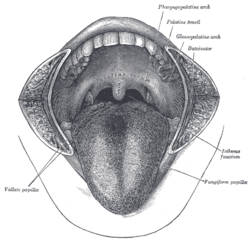| This article needs additional citations for verification. Please help improve this article by adding citations to reliable sources. Unsourced material may be challenged and removed. Find sources: "Fauces" throat – news · newspapers · books · scholar · JSTOR (July 2019) (Learn how and when to remove this message) |
| Fauces | |
|---|---|
 A view of the fauces through the mouth cavity. The cheeks have been slit transversely and the tongue pulled forward. (Fauces labelled as Isthmus faucium at center right.) A view of the fauces through the mouth cavity. The cheeks have been slit transversely and the tongue pulled forward. (Fauces labelled as Isthmus faucium at center right.) | |
 Pharynx Pharynx | |
| Details | |
| System | lymphoid system |
| Artery | faucial artery |
| Vein | faucial vein |
| Nerve | brachial plexus |
| Lymph | cervical nodes |
| Identifiers | |
| Latin | fauces |
| TA98 | A05.2.01.002 |
| TA2 | 2846 |
| FMA | 55006 |
| Anatomical terminology[edit on Wikidata] | |
The fauces, isthmus of fauces, or the oropharyngeal isthmus is the opening at the back of the mouth into the throat. It is a narrow passage between the velum and the base of the tongue.
The fauces is a part of the oropharynx directly behind the oral cavity as a subdivision, bounded superiorly by the soft palate, laterally by the palatoglossal and palatopharyngeal arches, and inferiorly by the tongue. The arches form the pillars of the fauces. The anterior pillar is the palatoglossal arch formed of the palatoglossus muscle. The posterior pillar is the palatopharyngeal arch formed of the palatopharyngeus muscle. Between these two arches on the lateral walls of the oropharynx is the tonsillar fossa which is the location of the palatine tonsil. The arches are also known together as the palatine arches.
Each arch runs downwards, laterally and forwards, from the soft palate to the side of the tongue. The approximation of the arches due to the contraction of the palatoglossal muscles constricts the fauces, and is essential to swallowing.
Faucitis

Inflammation of the fauces, known as faucitis, is seen in animals. In cats, faucitis is usually a secondary disease to gingivitis but can be a primary disease. In this species faucitis is usually caused by bacterial and viral infections although food allergies need to be excluded in any diagnosis. Treatment is symptomatic and includes broad-spectrum antibiotics and in severe cases where cats are inappetant, corticosteroids (often given as depot forms, e.g. depomedrol) or chemotherapy (e.g. chlorambucil).
See also
| Anatomy of the mouth | |
|---|---|
| Lip | |
| Cheek | |
| Palate | |
| Gums | |
| Glands | |
| Teeth |
|
| Tongue | |
| Back of mouth | |
References
- Saladin, Kenneth (2011-01-13). Anatomy & Physiology: The Unity of Form and Function. McGraw-Hill Education. p. 958. ISBN 9780073378251.
- "Definition of FAUCES".
- Singh, Vishram (2014). Textbook of anatomy head, neck and brain. Volume 3 (Second ed.). Elsevier. pp. 208–210. ISBN 9788131237274.